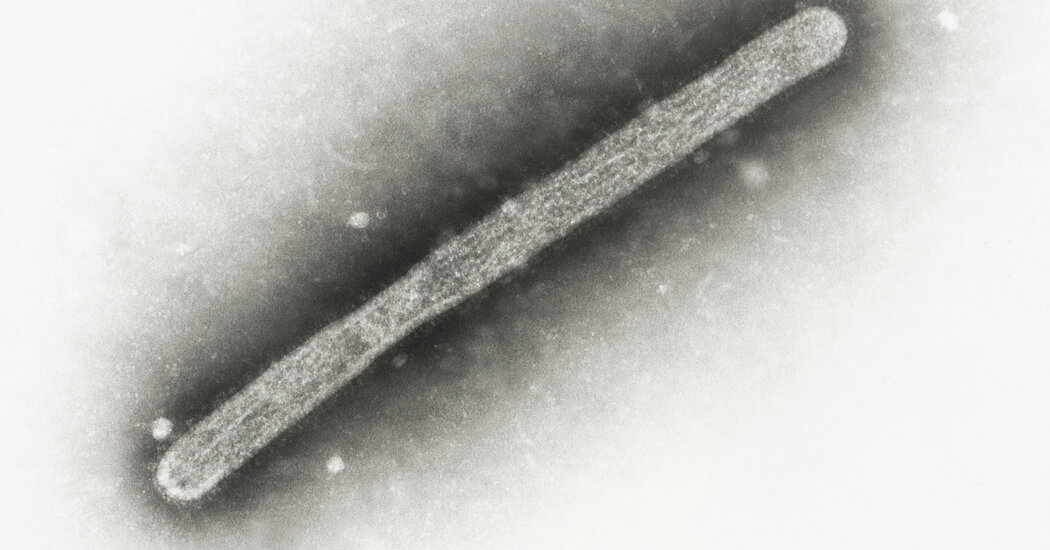
A Michigan farm worker has been diagnosed with avian influenza, state officials announced Wednesday, making it the second human case associated with the outbreak among cows.
Officials said the individual was infected with the virus, called H5N1, after being exposed to infected livestock. The individual had only mild symptoms and has fully recovered, officials said. They did not provide further details to protect the privacy of the farm and the workers, they said.
In 2022, a person in Colorado with direct exposure to infected poultry became the first confirmed human case of H5N1 in the United States. Last month, the Centers for Disease Control and Prevention reported an H5N1 infection in a worker at a Texas dairy farm — the first case associated with the outbreak among cows.
The detection of this latest case does not suggest that bird flu was widespread among people, officials said, adding that the risk to the public remains low.
“This virus is being monitored closely and we have seen no signs of human-to-human transmission at this time,” Dr. Natasha Bagdasarian, Michigan's chief medical officer, said in a statement.
However, the case suggests that as infected herds increase, agricultural workers continue to be at elevated risk of avian influenza. “This case was not unexpected,” said Dr. Nirav Shah, principal deputy director of the CDC
A nasal swab from the individual tested negative for the H5N1 virus, but an eye swab received by the agency on Tuesday tested positive, Dr. Shah said. Patients in Michigan and Texas reported experiencing only ocular symptoms, although in the Texas case, eye and nasal swabs both tested positive.
The CDC recommends that doctors collect both nasal and eye swabs from people exposed to the virus. “That's why it's really important to make sure that samples are taken in full compliance with CDC guidelines,” said Dr. Shah.
Veterinarians have reported that some farm workers have developed flu-like symptoms, but few farmers and farm workers have agreed to be tested for the cause. In Michigan, farm workers exposed to infected animals were asked to report even mild symptoms and testing for the virus was made available, Dr. Bagdasarian said. As of Wednesday, the CDC had only tested about 40 people, agency officials said.
The Michigan farm worker was being monitored because he worked on a farm with herds known to be infected and received a daily text message from the Michigan health department asking if they had symptoms.
“When the worker indicated that it was, public health sprung into action, culminating in the findings we report today,” Dr. Shah said.
“We found this case because we were looking for it, and we were looking for it because we were prepared,” he added.
According to the U.S. Department of Agriculture, the virus has been detected on 52 dairy farms in nine states. But the epidemic is believed to be much more widespread. Michigan officials reported four infected farms that were not included in the federal count. The Food and Drug Administration found traces of the virus in 20% of dairy products sampled from supermarket shelves in 17 states.
The virus was likely transmitted from wild birds to dairy cows in a single spillover event in the Texas Panhandle as early as last December, scientists said. Federal officials didn't confirm the first infections until late March.
Cows were thought not to be susceptible to the virus and the virus spread unnoticed among them without visible symptoms, the studies found. The virus has been detected in some dairy herds with no known links to affected herds, suggesting that the virus has spread among asymptomatic cows and that there are infected herds that have not yet been identified.
The virus may have spread among cows largely through contaminated milk, which contains high levels of the virus. The virus also spread from dairy farms to poultry farms, possibly through the movement of contaminated vehicles or equipment. Transporting infected cows from Texas may have spread the infection as far away as North Carolina and Michigan.
During the outbreak, the virus has acquired dozens of new mutations, including some that could make it more adept at spreading between species.
The Texas farm worker who was diagnosed with severe conjunctivitis in April but made a full recovery, CDC officials reported earlier this month. Officials were unable to test the individual's social contacts.
Farm owners have been reluctant to test their workers or livestock, fearful of the financial consequences. And except in extraordinary circumstances, federal and state officials cannot force farmers or agricultural workers to get tested.
To prepare for the possibility of additional cases, federal agencies have begun filling and completing about 4.8 million doses of a vaccine that is well compatible with the H5N1 strain currently circulating, officials said.
To identify how the virus is evolving, CDC scientists are sequencing the virus isolated from the infected individual and will compare it to the virus isolated from infected cows in Michigan and the infected dairy worker in Texas, Dr. Shah said.
Noah Weiland contributed to the reporting.
